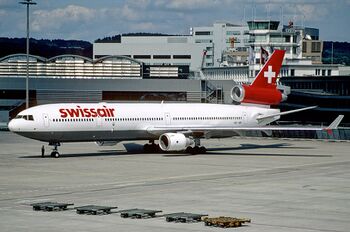Swissair Flight 111
 | |
| Date | 2 September 1998 |
|---|---|
| Location | Atlantic Ocean, near Peggy’s Cove, Nova Scotia, Canada |
| Deaths | 229 |
| Survivors | 0 |
| Description | A 1998 crash of the "UN shuttle". It was subject to the most expensive transport accident investigation in Canadian history, the chief forensic scientist of which claimed in 2011 that he was not allowed to pursue clear evidence of an incendiary device. |
Swissair Flight 111 was a scheduled international passenger flight from John F. Kennedy International Airport in New York City, United States, to Cointrin International Airport in Geneva, Switzerland. On 2 September 1998 at 01:31:18 UTC, it crashed into the Atlantic Ocean at the entrance to St. Margarets Bay, Nova Scotia, Canada. All 229 passengers and crew on board the aircraft were killed.
Contents
Cargo and Passengers
Swissair Flight 111 was known as the "UN shuttle" because of its popularity with United Nations officials traveling between the organization's two biggest centers. The flight also carried business executives, scientists, and researchers.
Notable passengers included a Saudi prince, a relative of the former Shah of Persia, a senior UN official, Jonathan Mann, former head of the World Health Organization's AIDS program, and his wife, AIDS researcher Mary Lou Clements-Mann.
The cargo included 49.8 kg of banknotes, and 2 kg of diamonds to the value of half a billion dollars, that were never found.
Official Investigation
The investigation became the largest and most expensive transport accident investigation in Canadian history, costing CA$57 million (US$ 48.5 million) over five years.[1] 4000 people were involved and it took 4 years. 98 percent of the aircraft was salvaged from the bottom of the sea with great effort and it was reconstructed piece by piece in a hall in order to find the exact cause of the crash.
The investigation carried out by the Transportation Safety Board of Canada (TSB) concluded that flammable material used in the aircraft's structure allowed a fire to spread beyond the control of the crew, resulting in the crash of the aircraft.
According to the investigation, both the cockpit voice recorder (CVR) and flight data recorder (FDR) had stopped recording when the aircraft lost electrical power at approximately 10,000 ft (3,000 m), 5 minutes and 37 seconds before impact. Both were found by the submarine HMCS Okanagan using sonar to detect the underwater locator beacon signals and were quickly retrieved by Canadian Navy divers (the FDR on 6 September and the CVR on 11 September 1998). The lack of flight recorder data for the last six minutes of the flight added significant complexity to the investigation and was a major factor in its lengthy duration. The TSB team had to reconstruct the last six minutes of flight entirely from the physical evidence.
Also, from 20:33 – 20:47 EDT (00:33 to 00:47 UTC), the aircraft experienced a radio blackout for approximately thirteen minutes, which was concluded to be caused by communication radio tuning errors.[2]
Whistleblowers
In 2011, Tom Juby, the chief forensic scientist of the investigation at the time, stated there was clear evidence of an incendiary device - which he was not allowed to pursue.
The former chief forensic scientist said he had been urged by the Canadian transport security agency (TSB) not to investigate strong evidence of a crime. He was also ordered to remove any evidence of magnesium or a bomb attack from his log, which is a criminal act in Canada.
Something that supports the possibility of foul play, is the original findings from the metal expert Jim Brown, commissioned by the Canadian investigators. He found elements on board that should not have been there. Above all, there was around ten times more magnesium than should have been the case. Magnesium could have been used for an incendiary device, but that possibility was never investigated.[3]
According to some (uncorroborated) sources, strange things have happened in this context in Switzerland as well. Three experts who were involved in the investigation on the Swiss side experienced fatal accidents under mysterious circumstances. One of them is Guido Hirni, a B-helicopter test expert from the FOCA (Federal Office for Civil Aviation), who, as a very experienced pilot, crashed under strange circumstances. A colleague is said to have been pushed in front of a train. [4]
Documentary Film
In 2014, the The Canadian broadcaster CBC made a documentary, Swissair 111 : The Untold Story, about the crash.[5]
"War" on Switzerland
The crash came a few weeks after a settlement with the World Jewish Congress (WJC) led by Edgar Bronfman. WJC wrote: "On August 13, 1998, the Swiss people awoke to find that a three-year "war" over Holocaust assets had ended. The day before, a group of Swiss banks had agreed to pay $1.25 billion to thousands of Holocaust survivors and their heirs, after more than fifty years of stonewalling over the fate of their assets...After two and a half years of "political war" with the Swiss, the fighting was over. It was not perfect justice, but then again nothing like this really ever is. For Edgar Bronfman and the WJC, it was success on a grand scale."[6]
References
- ↑ https://web.archive.org/web/20090223215759/http://news.bbc.co.uk/1/hi/world/europe/2893019.stm
- ↑ "Fire on Board". Mayday. Season 1. Episode 3. 2003. Discovery Channel Canada / National Geographic.
- ↑ https://www.sueddeutsche.de/panorama/swissair-absturz-doku-naehrt-zweifel-an-unfalltheorie-1.1145822
- ↑ http://alles-schallundrauch.blogspot.com/2011/09/war-der-absturz-von-swissair-111-kein.html
- ↑ https://vimeo.com/467765324
- ↑ https://archive.is/57vr5